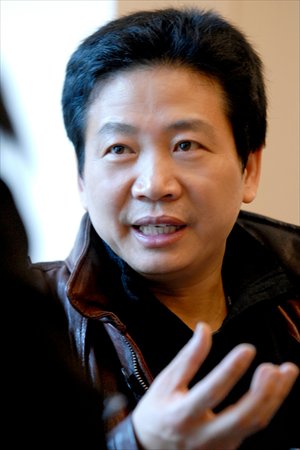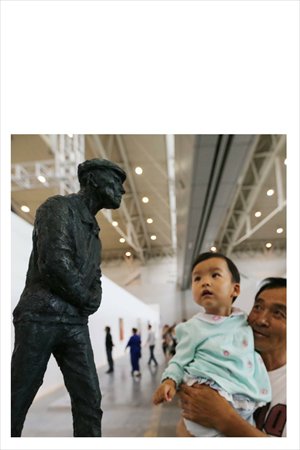Letting art prosper
By Li Jingjing in Urumqi Source:Global Times Published: 2014-7-8 20:13:01
Zhang Zikang talks about building up the art industry in Xinjiang

Zhang Zikang Photo: Courtesy of Zhang Zikang

A man and a young boy appreciate a statue together at The 1st China Xinjiang International Arts Biennale in Xinjiang Photo: CFP
"For artists, no place can compare with Xinjiang in terms of resources. The geographical features, multi-cultural resources of multiple ethnic groups... there are just so many things to amaze you and many things are already art works in and of themselves. It should be a place that generates emerging artists," said the 50-year-old Zhang Zikang.Zhang finds it puzzling that despite all these artistic advantages the Xinjiang Uyghur Autonomous Region holds for artists - the region is home to 47 ethnic groups and has numerous mountains, lakes and glaciers - the art industry in the region seems far less developed than other areas in China. Almost no influential artists from Xinjiang are known worldwide or even nationwide and no public art museums currently exist in the region.
So when Zhang was dispatched to Xinjiang in 2011 as the deputy director-general of the Department of Culture for Xinjiang, the motivation to help the culture and art of the region prosper drove him to establish much needed platforms for exchange between Xinjiang and other regions.
Broadening horizons
Since 2004, Zhang has been the director of the Today Art Museum in Beijing and the editor-in-chief of the magazines Oriental Art and Art Today. Through the efforts of Zhang and his team, the Today Art Museum was able to become the first highly successful private museum in the Chinese mainland. For his contributions, he has been regarded as a crucial person in helping raise the status of private art galleries in the mainland.
Due to his profound experience in organizing art events, he was sent to work in Xinjiang. "I think I can play a greater role in Xinjiang than at the Today Art Museum," he said.
Working in Xinjiang over the past three years, he has been able to witness the problems with the art industry in the region.
"They have become used to having a single methodology in creating art. Everybody uses a similar way to draw. There isn't enough vitality, so many artists don't get the chance to develop their real talent," he said.
During the two biennales he helped organized in Xinjiang, Zhang tried to bring various kinds of art - traditional and contemporary, domestic and international, paintings and installation art - to the region in the hope of expanding horizons and developing creativity.
In 2012, Zhang helped organize the The 1st China-Xinjiang Contemporary Art Biennale in Urumqi to give people here a general outline of the current state of Chinese contemporary art. This autonomous-region-level exhibition gathered top Chinese contemporary artists like Chen Danqing, Xu Bing and Liu Xiaodong.
With that experience under his belt, Zhang was able to help this year's biennale, The 1st China Xinjiang International Arts Biennale, become even bigger. Supported by both the Ministry of Culture and the Xinjiang government, and featuring works by 132 artists from 18 countries, a 5-kilometer-long exhibition route, one main exhibition, three themed exhibitions and three peripheral exhibitions, the biennale has shown unprecedented scale.
Since this latest exhibition first opened on June 25, attendance has ranged between 3,000-5,000 daily visits with nearly 20,000 visits on the Sunday of June 29. Zhang estimated that the exhibition will have been visited roughly 300,000 times by the time it ends on July 20 - a staggering number for an exhibition in Urumqi considering the city's population sits at 3.5 million. This number means quite a bit to Zhang since it means he has gotten closer to his goal of leading the public to embrace art.
Cultural infrastructure
"Many Xinjiang artists became big stars after heading into China's central regions. Why weren't they able to make a name for themselves in Xinjiang? It's not they were less talented or lacked resources," Zhang told the Global Times.
"What it [Xinjiang] needs is academic platforms, like exhibitions and galleries." Establishing these platforms has been Zhang's main job these past three years.
Bai Gang, vice-president of the Xinjiang Painting Academy believes Xinjiang artists can compete with artists from anywhere else when it comes to skill. At the same time, artists from elsewhere tend to find things that inspire them when they come to Xinjiang. As such these biennales provide a platform for artists from inside and outside the region to express themselves as well as exchange ideas with each other.
"These two biennales have had great influence in Xinjiang. They have allowed people to see diverse elements and a spirit of inclusiveness. I saw the same artists come here in the morning, again in the afternoon and then again the next day, just watching the exhibition quietly. Ordinary people really need it as well," Bai said.
Although getting exhibitions and galleries established in Xinjiang is a first step, how to continue to make them influential is another challenge.
Zhang explained that although solving issues concerning people's livelihoods in the region no doubt takes priority, the cultivation of talent is also important.
"If we don't start now, the space for future development will be limited. What we lack when it comes to establishing cultural businesses is cultural creativity and talent cultivation. Without that we won't be able to manage," Zhang said, going on to explain that although using resources from other areas in China is an option, without a strong local cultural infrastructure, the impact of any type of cultural program would be very ineffective.
A step forward
Realizing the need for supporting cultural infrastructure, Zhang decided to do more. Besides organizing exhibitions, Zhang, along with other local artists, are currently working to establish Xinjiang's first public art museum. Also the director of the preparatory office for the still-to-be-built art museum, Zhang revealed to the Global Times that he spent long hours designing and figuring out how to build a good art museum for the region. Currently designs are finished and construction is about to start in Urumqi.
"Galleries are extremely important for Xinjiang as art museums bear the values that all humans believe in," said Zhang.
Explaining the importance of art museums he points out that when people view art from a particular religion, even if they don't know anything about said religion, they are inspired to know more, "This type of communication can help create understanding between ethnic groups," he added.
Posted in: Celebrity